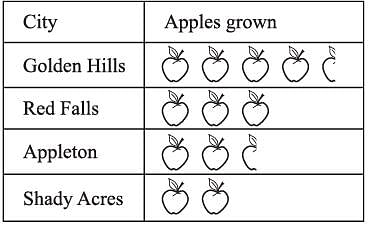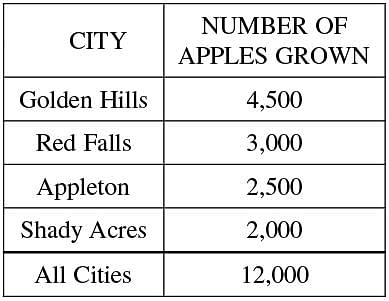ACT Exam > ACT Questions > The table below shows the number of pounds of...
Start Learning for Free
The table below shows the number of pounds of apples grown last year in 4 cities. (Each whole apple on the graph represents 1,000 pounds of apples.) According to the graph, what fraction of the apples grown in all 4 cities were grown in Appleton?


- a)5/24
- b)1/4
- c)1/6
- d)5/19
- e)3/16
Correct answer is option 'A'. Can you explain this answer?
Verified Answer
The table below shows the number of pounds of apples grown last year i...
The correct answer is A. To find the fraction of apples grown in Appleton, divide the number of apples grown in Appleton by the total number of apples grown. The table below shows the conversion of apple symbols to numbers for the 4 cities, as well as the total number of apples grown.

The fraction of apples grown in Appleton is 2500/12,000, or 5/24.
If you selected answer choice D, the most common incorrect answer, you probably used the number grown in Appleton divided by the total number of apples from the other 3 towns only.

The fraction of apples grown in Appleton is 2500/12,000, or 5/24.
If you selected answer choice D, the most common incorrect answer, you probably used the number grown in Appleton divided by the total number of apples from the other 3 towns only.
Most Upvoted Answer
The table below shows the number of pounds of apples grown last year i...
The correct answer is A. To find the fraction of apples grown in Appleton, divide the number of apples grown in Appleton by the total number of apples grown. The table below shows the conversion of apple symbols to numbers for the 4 cities, as well as the total number of apples grown.

The fraction of apples grown in Appleton is 2500/12,000, or 5/24.
If you selected answer choice D, the most common incorrect answer, you probably used the number grown in Appleton divided by the total number of apples from the other 3 towns only.

The fraction of apples grown in Appleton is 2500/12,000, or 5/24.
If you selected answer choice D, the most common incorrect answer, you probably used the number grown in Appleton divided by the total number of apples from the other 3 towns only.

|
Explore Courses for ACT exam
|

|
Similar ACT Doubts
The table below shows the number of pounds of apples grown last year in 4 cities. (Each whole apple on the graph represents 1,000 pounds of apples.) According to the graph, what fraction of the apples grown in all 4 cities were grown in Appleton?a)5/24b)1/4c)1/6d)5/19e)3/16Correct answer is option 'A'. Can you explain this answer?
Question Description
The table below shows the number of pounds of apples grown last year in 4 cities. (Each whole apple on the graph represents 1,000 pounds of apples.) According to the graph, what fraction of the apples grown in all 4 cities were grown in Appleton?a)5/24b)1/4c)1/6d)5/19e)3/16Correct answer is option 'A'. Can you explain this answer? for ACT 2025 is part of ACT preparation. The Question and answers have been prepared according to the ACT exam syllabus. Information about The table below shows the number of pounds of apples grown last year in 4 cities. (Each whole apple on the graph represents 1,000 pounds of apples.) According to the graph, what fraction of the apples grown in all 4 cities were grown in Appleton?a)5/24b)1/4c)1/6d)5/19e)3/16Correct answer is option 'A'. Can you explain this answer? covers all topics & solutions for ACT 2025 Exam. Find important definitions, questions, meanings, examples, exercises and tests below for The table below shows the number of pounds of apples grown last year in 4 cities. (Each whole apple on the graph represents 1,000 pounds of apples.) According to the graph, what fraction of the apples grown in all 4 cities were grown in Appleton?a)5/24b)1/4c)1/6d)5/19e)3/16Correct answer is option 'A'. Can you explain this answer?.
The table below shows the number of pounds of apples grown last year in 4 cities. (Each whole apple on the graph represents 1,000 pounds of apples.) According to the graph, what fraction of the apples grown in all 4 cities were grown in Appleton?a)5/24b)1/4c)1/6d)5/19e)3/16Correct answer is option 'A'. Can you explain this answer? for ACT 2025 is part of ACT preparation. The Question and answers have been prepared according to the ACT exam syllabus. Information about The table below shows the number of pounds of apples grown last year in 4 cities. (Each whole apple on the graph represents 1,000 pounds of apples.) According to the graph, what fraction of the apples grown in all 4 cities were grown in Appleton?a)5/24b)1/4c)1/6d)5/19e)3/16Correct answer is option 'A'. Can you explain this answer? covers all topics & solutions for ACT 2025 Exam. Find important definitions, questions, meanings, examples, exercises and tests below for The table below shows the number of pounds of apples grown last year in 4 cities. (Each whole apple on the graph represents 1,000 pounds of apples.) According to the graph, what fraction of the apples grown in all 4 cities were grown in Appleton?a)5/24b)1/4c)1/6d)5/19e)3/16Correct answer is option 'A'. Can you explain this answer?.
Solutions for The table below shows the number of pounds of apples grown last year in 4 cities. (Each whole apple on the graph represents 1,000 pounds of apples.) According to the graph, what fraction of the apples grown in all 4 cities were grown in Appleton?a)5/24b)1/4c)1/6d)5/19e)3/16Correct answer is option 'A'. Can you explain this answer? in English & in Hindi are available as part of our courses for ACT.
Download more important topics, notes, lectures and mock test series for ACT Exam by signing up for free.
Here you can find the meaning of The table below shows the number of pounds of apples grown last year in 4 cities. (Each whole apple on the graph represents 1,000 pounds of apples.) According to the graph, what fraction of the apples grown in all 4 cities were grown in Appleton?a)5/24b)1/4c)1/6d)5/19e)3/16Correct answer is option 'A'. Can you explain this answer? defined & explained in the simplest way possible. Besides giving the explanation of
The table below shows the number of pounds of apples grown last year in 4 cities. (Each whole apple on the graph represents 1,000 pounds of apples.) According to the graph, what fraction of the apples grown in all 4 cities were grown in Appleton?a)5/24b)1/4c)1/6d)5/19e)3/16Correct answer is option 'A'. Can you explain this answer?, a detailed solution for The table below shows the number of pounds of apples grown last year in 4 cities. (Each whole apple on the graph represents 1,000 pounds of apples.) According to the graph, what fraction of the apples grown in all 4 cities were grown in Appleton?a)5/24b)1/4c)1/6d)5/19e)3/16Correct answer is option 'A'. Can you explain this answer? has been provided alongside types of The table below shows the number of pounds of apples grown last year in 4 cities. (Each whole apple on the graph represents 1,000 pounds of apples.) According to the graph, what fraction of the apples grown in all 4 cities were grown in Appleton?a)5/24b)1/4c)1/6d)5/19e)3/16Correct answer is option 'A'. Can you explain this answer? theory, EduRev gives you an
ample number of questions to practice The table below shows the number of pounds of apples grown last year in 4 cities. (Each whole apple on the graph represents 1,000 pounds of apples.) According to the graph, what fraction of the apples grown in all 4 cities were grown in Appleton?a)5/24b)1/4c)1/6d)5/19e)3/16Correct answer is option 'A'. Can you explain this answer? tests, examples and also practice ACT tests.

|
Explore Courses for ACT exam
|

|
Signup for Free!
Signup to see your scores go up within 7 days! Learn & Practice with 1000+ FREE Notes, Videos & Tests.


























